Widex has never been afraid to march to the beat of a different drummer. As Widex President and CEO Jan Tøpholm says, “We’ve never necessarily had the goal of being the largest hearing aid manufacturer, but we’ve always strived to be first in technology.”
The privately owned 55-year-old Danish company accounts for approximately 1 in 10 hearing aids sold worldwide and has a reputation for being something of a technological maverick. Widex hearing aids often go against the grain when it comes to “standard” industry principles, thereby presenting dispensing professionals with a wider choice in technologies. Among its several hearing aid “firsts” are digital ITEs (Senso in 1995), the use of longer attack/release times, the Sensogram, and in-situ fittings. The company is also known for packing a lot of new features into each product introduction, including its latest Clear440 and DEX wireless devices, and it has been rewarded with one of the most loyal customer bases in the market.
Although Widex plans on retaining these types of hallmarks, a new Widex is emerging in both Denmark and the United States. In Denmark, its new state-of-the-art headquarters has further strengthened the company so that it can take better advantage of its “all-under-one-roof” synergies and move more quickly.
In the United States, Widex A/S purchased Widex Hearing Aid Company, the company’s privately owned US distribution arm, in November 2010. The new Widex USA, led by its president Jake Haycock, has since bolstered its staff and plans to update its own headquarters.
“For the customers who have not dealt with us in the past, we are essentially a new company and we’re going to be taking a fresh approach to the market,” says Haycock. “We’re hoping they will give us a call, because we’re looking forward to meeting them and finding ways to mutually help each other serve more patients and build our businesses. For those who have used our products in the past, I want to thank them for their support, and I assure them that they will only see improvements in Widex from this point on.”
Outgrowing Old Home Leads to New Opportunities
Another thing that distinguishes Widex from most hearing aid manufacturers is a penchant for designing and producing everything that goes into their hearing aids. A walk through their ultra-modern and cafeteria-clean production center reveals scores of machines chugging out mini-BTE casings next to scores of other machines producing a constellation of tiny parts from wax guards to hearing aid cleaning kits. With the exception of the actual semiconductor chip manufacturing (which is fully designed, but not fabricated, in-house), almost everything found in a Widex hearing aid is produced at its Danish facilities or a smaller plant in Belgium.

|
|
| Family ties. The sons of the two men who founded Widex—Erik Westermann and Christian Tøpholm (shown at right at the company’s founding in 1956)—work together to guide the company, and often sound more like close siblings than business partners. Pictured are (standing) Widex President and CEO Jan Tøpholm and (sitting, l to r) Executive Vice Presidents Anders Westermann and Søren Westermann. | 
|
As its sales grew, however, Widex gradually ran out of space at its former headquarters in Vaerlose, Denmark, even after they added an expansive building adjacent to the original one. “[The facility] was becoming impractical, as the distance from one end to the other was close to one-third of a mile,” says Tøpholm. “All of the buildings were connected with bridges or tunnels, but this became impractical especially due to the fact that, whenever one department needed to expand, it necessitated the moving of three other departments.
“So, we decided to build completely anew,” continues Tøpholm. “And this was the main reason we ultimately built a circular-shaped facility. Because we’re engineers, we asked ourselves ‘What is the greatest volume in the smallest surface area?’ and that, of course, is a circle. We now have double the space that we had in Vaerlose, but we have one-third the distance to travel from the farthest two points compared to our old house.”
The new Widex headquarters is composed of two large 4-story concentric-buildings—with one ring inside the other—that has an exterior of large glass windows and solar panels. But perhaps the most noticeable feature of the building is the football-field-sized windmill next to it, one component of the building’s elaborate energy conservation package that includes solar panels, geothermal heating, and computerized “smart” area controls for making the facility carbon-neutral. (For more information, see sidebar below.)
Having all of its departments under one roof—including production—is a unique facet of Widex, as most hearing aid companies have moved their production facilities to Asia. Although Tøpholm notes that labor costs are continuing to rise in Denmark, he says that the synergies created by all 650 employees make a qualitative difference in the final product that helps counterbalance the extra labor costs.
Dynamic US Market Necessitates Changes and Greater Investment
One of the most important hearing industry acquisitions of 2010 involved Widex A/S purchasing its US distributor, Widex Hearing Aid Company, a company that in many ways paralleled its Danish counterpart: it had been established by two forward-thinking gentlemen, Harold Spar and Henry Meltsner (who also founded Hal-Hen), and later prospered under the direction of their sons, Eric Spar and Ron Meltsner.1
Both companies have, since their origins in the early 1950s, maintained a close and fruitful business relationship. However, the changing market dynamics in the United States presented increasing challenges for an independent distributor. Margins eroded and, at the same time, significant investments were necessary to expand Widex’s position in the market while ensuring a high level of service to dispensing professionals.
It was a difficult move. Tøpholm says that he has been close friends with Ron Meltsner and Eric Spar and their fathers for more than 50 years. “They did a great job of establishing and running the company. Their entire approach to the US market was never in question. But it’s simply becoming more and more difficult to operate two distinct companies [without the economy-of-scale synergies] because the market is changing.”
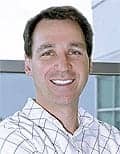
Widex USA President Jake Haycock
Taking the reins as new president of Widex USA is Jake Haycock who had previously headed Widex Canada in Burlington, Ontario, where he’d spent 9 years building that organization after the Canadian distributorship was purchased by Widex A/S. “When I first took over the distributorship and started Widex Canada, we didn’t have a high market share, our offices were in an older facility, and we didn’t have a marketing department. So, it was my job to build a new state-of-the-art facility, bring in managers who could develop the territories, and basically start from scratch with a management team. One of my first goals was to double our sales and support staff and increase our presence in the market.
“Fast-forward 9 years later,” continues Haycock, “and we are looking into establishing a new US facility that includes a training center. We’re also in the process of adding to what is already an exceptional staff. We’ve hired a new vice president of sales, Richard Jackson, and a vice president of marketing and business development, Rob Wolf—both well-known veterans in our industry. We’re also doubling the size of our sales team and support staff, which is a significant commitment, as well as getting more audiologists on the staff for training. Essentially, we’re looking at all areas of the organization that we might improve…And the reason for all these investments, of course, is to substantially increase our presence in the US market.”
More Product Introductions
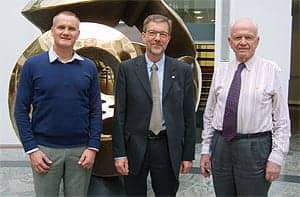
Widex A/S PR Manager Peter Hentze Knudsen, International Product Manager Ove Jensen, and company co-founder Erik Westermann.
Industry analysts have sometimes criticized Widex for its comparatively longer periods of time between new product introductions. In recent years, product life cycles have become as short as 18 months in some hearing aid categories, and not keeping pace can bring questions from dispensers.
However, shorter product life cycles and taking a page out of the book of fast-moving consumer goods (FMCG) have inherent downsides, according to Tøpholm, who is an engineer. “Product life cycles have become much shorter and that’s a competitive move, as well as a result of the manufacturers being bigger and fewer,” he says. “In my opinion, it’s not always a good thing. There is a required development time for any new hearing aid, and a typical new platform may take as long as 4 years. It goes without saying that it’s very engineering intensive to come up with advanced platforms. However, what happens when you launch products more frequently is that you get less and less new content with each product. Yet, you still have all the engineering, production, and sales and marketing expenses associated with a new launch. Essentially, for the end user and the dispenser, the price of hearing aids becomes higher due to these more frequent launches.
“In my opinion, in an ideal world, we would have less-frequent platform launches that contain much greater technological content [changes], because this would offer the same development at a lower cost,” says Tøpholm.
So are the analysts who criticize Widex about having longer product life cycles wrong? “You have to listen to the market,” says Tøpholm. “And, frankly, the market is now demanding new products all the time. I’m just saying that, from an industry-wide standpoint, this may not be the most rational strategy.”
Tøpholm says that Widex will move toward a more aggressive product launch schedule. This will also produce greater marketing and sales opportunities for professionals who dispense Widex devices. “We anticipate that we will be coming to market with new products more quickly,” says Haycock. “The product life cycle is going to be [shortened] dramatically, so that’s one of our big changes and next steps.”
Adds Tøpholm, “We are certainly going to continue to develop products that define our company, technologically, from the others. You could also say we were relatively late in bringing a wireless product to market, but in my opinion we are offering a system that is a truly superior technical system with substantial benefits. Again, I think you’ll see that our system bears the mark of having had more development time.”
A “Clear” Wireless Benefit
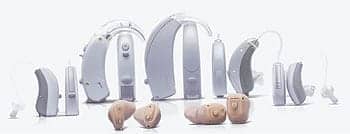
Widex Clear440 product line includes BTE, micro-BTE, RIC, RITE, ITE, and CIC models.
The new Widex Clear440 hearing aid line and associated wireless assistive listening devices (called DEX) took 6 years to develop and involved more than 20 electronic engineers for just the wireless transmission portion of the device, according to International Product Manager Ove Jensen, PhD.
Clear440 is a 15-channel wireless hearing aid designed to provide natural, high-quality sound in 5 programs plus the Zen (binaurally presented fractal music2) and DEX program. The devices employ WidexLink for both inter-ear and remote device capabilities so they can communicate and synchronize with each other or external devices instantly and without delay. This wireless technology is said to be exceptionally advanced in that it uses direct transmission similar to the 2.4 GHz technology found in Bluetooth, yet operates at very low power levels.
Through the use of several algorithms—including TruSound Softener for sudden impulse noises, IE Speech Enhancer for use in noisy listening environments, and Digital Pinna for enhanced sound localization—the system is designed for continual adjustment of discrete hearing aid functions in order to replicate the natural hearing experience even more closely, says Jensen. The aids can be programmed wirelessly.
Fusion is a new Clear440 312-battery sized mini-RIC/RITE device with three power levels (based on receiver size) and offered with various ear-tip and custom earmold options. Complementing the Clear440 line are numerous assistive devices, including the tiny RC-DEX (a remote control), as well as the TV-DEX for television listening and M-DEX for mobile phones.
(Editor’s Note: Launched in Europe during late 2010, Clear440 and several other wireless hearing industry products were delayed from entering the US market due to a review of FDA 510k premarket clearance procedures. At this writing, many of these products were not yet available in the United States.)
Acknowledgements
The editor thanks Widex USA Senior Director of Marketing James Cola and Widex A/S PR Manager Peter Hentze Knudsen for their assistance in this article.
References
- Strom KE. Hal-Hen & Widex USA celebrate landmarks. Hearing Review. 2006;13(12):40-48.
- 2. Kuk F, Peeters H, Lau C. The efficacy of fractal music employed in hearing aids for tinnitus management. Hearing Review. 2010;17(10):42.
CO2-Neutral Widex Headquarters Reflects “Natural” Engineering
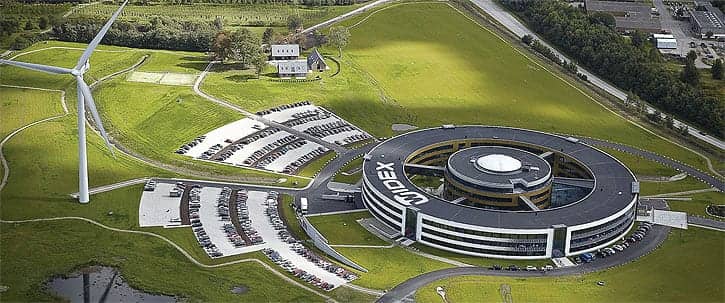
An aerial view of the Widex A/S headquarters near Lynge, Denmark, shows its circular design and open architecture. The new facility—constituted by two concentric rings that encircle gardens and courtyards—has a carbon-neutral environmental footprint. For power, it uses the large windmill (shown in the upper left) and solar panels, and it also utilizes an advanced geothermal heating and cooling system (part of which is shown in the picture below right).
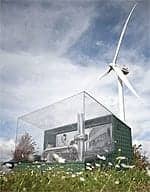
Question: What do you get when some of the world’s best micro-electronic engineers at one of the world’s largest hearing aid companies decide they need a new home for their headquarters and production facilities? Answer: A 394,000-sq-ft office space that is so efficient and futuristic it might make Buckminster Fuller and Arthur C. Clarke envious. Located near Lynge, Denmark, about 35 miles southwest of Copenhagen, the new Widex headquarters rises from the surrounding fields and forests like a just-arrived spaceship, with 20,000 solar cells, 3,800 windows, and a self-contained CO2-neutral power generation system.
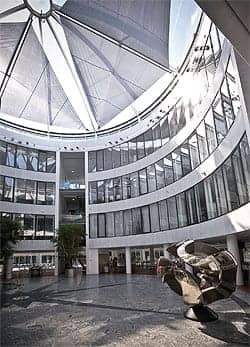
The inner ring and its open sunlit courtyard. Both of the building’s rings provide natural light and an open feel throughout the complex.
However, with its open and sunlit design, it is an extremely natural feeling—and nature-friendly—building. The new headquarters is actually composed of a pair of 4-story buildings that form two concentric rings linked by numerous bridges and surrounded by outdoor gardens and a central courtyard. Thus, nearly every office space, meeting room, and gathering place benefits from sunlight and a view of the surroundings or courtyard.
The new headquarters’ heating system is the first of its kind in Scandinavia. Called Aquifer Thermal Energy Storage (AFTES), it uses a system of ten geothermal heat transfer wells (see photo inset) that tap into the underground aquifer, heating the buildings in the winter and cooling them in the summer. Said to be much more efficient than traditional heating/cooling systems, AFTES reduces the building’s CO2 emissions by 70% (700 tons), or the equivalent of 250 gas-heated homes, according to the company. Because the building only “borrows” the water through a system of large pipes and pumps, the aquifer’s water is not actually used for anything except heating and cooling purposes.
It’s impossible to miss the 330-ft windmill that generates 3.4 million kWh of power—a major part of the facility’s goal to get “off the grid” and not rely on fossil fuels. In combination, with the power generated and saved by the windmill, AFTES geothermal system, and solar panels, the headquarters actually produces more power than it needs—so energy is transferred back into the power grid for use by the local community.
“We have designed a building for the future in another way,” states Widex President and CEO Jan Tøpholm. “It looks as though we’ve averted a world financial crisis, but we still have a climate and energy crisis. As a high-tech company, we have an obligation to ensure our building takes into account limited environmental resources as well.”
ORCA Celebrates Its 10th Year
The Widex Office of Research in Clinical Amplification (ORCA) in Lisle, Ill (a suburb of Chicago), led by Vice President of Audiology Francis Kuk, PhD, is celebrating its 10th anniversary in 2011. The brainchild of Søren Westermann and recently retired Manager of Audiology Research Carl Ludvigsen, ORCA was established to conduct research projects that deal primarily with hearing aid performance in clinical studies, but its focus is not restricted from the realm of basic science and other projects that further the field’s knowledge about hearing aid fitting and selection.
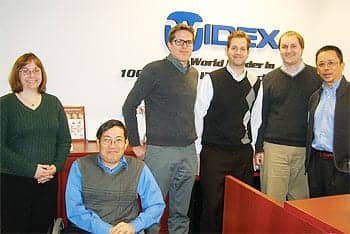
The Widex USA ORCA staff (l to r): Senior Research Audiologist Denise Keenan, MA; Research Scientists Chi Lau, PhD, and Petri Korhonen, MSc; Education Coordinator Daniel Tibbs, AuD; Research Engineer Bryan Crose, BSEE; and Vice President of Audiology Francis Kuk, PhD.
For example, Kuk and colleagues have provided numerous practical articles in The Hearing Review and other trade and peer-reviewed journals, and they regularly conduct training seminars for clinicians, as well as Widex sales representives. Additionally, Education Coordinator Daniel Tibbs, AuD, operates the Widex University program designed to support audiology education throughout the country.
“We’re not only focused on research that will ultimately make better hearing-related products, but we’re also involved in supporting dispensing professionals, students, and our staff so we’re making better clinicians.”
In 2006, a second ORCA office was established in Stockholm, Sweden, and is led by audiologist Karolina Smeds, PhD.
“ORCA is constantly giving us new insights,” says Tøpholm. “They have a direct interaction with our [in-house audiology staff of about 60 scientists] and coordinate research with them. But, importantly, they also get their own ideas about what kind of independent research they would like to pursue. I think it’s good that we have what might be viewed as two divisions in Widex that are looking into important audiological questions, and these audiology groups complement each other well. In this way, we don’t have a narrow tunnel to look through [during product development], as ORCA provides us with research and findings completely separate from the research conducted [in Denmark].”
Citation for this article:
Strom KE. Widex builds for future with a new “green” home and a “Clear” route in products and research. Hearing Review. 2011;18(4):44-52.


.gif)

